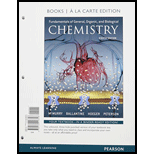
(a)
Interpretation:
The balanced equations for the reaction of given compounds should be identified.
Concept Introduction:
Balanced Chemical Equation: On accordance with law of conservation of mass, for any
E.g. The acid of 1 Equivalent will react with 1 Eq of metal hydroxide which results in formation of water and salt.
(b)
Interpretation:
The balanced equations for the reaction of given compounds should be identified.
Concept Introduction:
Balanced Chemical Equation: On accordance with law of conservation of mass, for any chemical reaction, total masses of reactants and products must be equal.
E.g. The acid of 1 Equivalent will react with 1 Eq of metal hydroxide which results in formation of water and salt.
Trending nowThis is a popular solution!

Chapter 10 Solutions
Fundamentals of General, Organic, and Biological Chemistry, Books a la Carte Plus Mastering Chemistry with Pearson eText -- Access Card Package (8th Edition)
- If you measured the rate of reaction at 20°C to be 1.11 x 10-5 M/s when using 0.080 M I1- and 0.040 M S2O82-. Approximately how long will the reaction take if you were to increase the temperature to 30 °C?arrow_forwardwhich statement is true for the following reaction?arrow_forwardCalculate ΔG for the reaction H2O(l) ⇆ H+(aq) + OH−(aq) at 25°C for the following conditions. [H+] = 3.1 M, [OH−] = 4.7 ×10−4 Marrow_forward
- How many steps are depicted in this reaction coordinate diagram?arrow_forwardFor the following reactions, identify the atom(s) being oxidized and reduced:arrow_forwardFor the series of reactions below, what is the overall reaction and the value of ∆Go’(kJ/mol) for this set of reactions? Is the reaction spontaneous? (1) 2 Pi+ H2O ➔Pyrophosphate+ H2O (with 5 mM Mg2+) (2) (Mg)Pyrophosphate + AMP ➔(Mg)ATP (3) (Mg)ATP + creatine ➔creatine-phosphate + (Mg)ADParrow_forward
- The phosphoryl group transfer potentials for glucose-1-phosphate and glucose-6-phosphate are 20.9 kJ/mol and 13.8 kJ/mol, respectively. (a) What is the equilibrium constant for the reaction shown below at 25 °C? (b) If a mixture was prepared containing 1 m glucose-6-phosphate and 1 x 10-3 M glucose-1-phosphate, what would be the thermodynamically favored direction for the reaction?arrow_forwardPotassium nitrate is widely used in industries. The reaction for the industrial production of KNO3 is summarized in the equation below; 4KCl + 4 HNO3 + O2 → 4 KNO3 + 2 Cl2 + 2 H2O Which of the following statements below is correct about the production of KNO3? a. A redox reaction; KCl is a reducing agent and O2 is an oxidizing agent b. A redox reaction; HNO3 is a reducing agent and Cl is an oxidizing agent c. Not a redox reaction d. A redox reaction; KCl is a reducing agent and KNO3 is an oxidizing agent e. A redox reaction; HNO3 is a reducing agent and KNO3 is an oxidizing agentarrow_forwardPotassium superoxide, KO2, is used in rebreathing masks to generate oxygen according to the reaction below. If the mask contains 0.250 mol KO2 and 0.200 mol water, what is the limiting reagent? How many moles of excess reactant will there be once the reaction is complete? 4 KO2(s) + 2 H2O(ℓ) → 4 KOH(s) + 3 O2(g)arrow_forward
- For the following reaction, 4.91 grams of water are mixed with excess chlorine gas. The reaction yields 12.5 grams of hydrochloric acid.chlorine (g) + water (l) hydrochloric acid (aq) + chloric acid (HClO3) (aq) What is the theoretical yield of hydrochloric acid ? grams What is the percent yield of hydrochloric acid ? %arrow_forwardAssume that the reaction Arabinose +Pi <> Arabinose-6-P has a delta G of +13.0 kJ/mol and the reaction XTP <> XDP + Pi has a delta G of -25.7 kJ/mol. Calculate the delta G for the combined reaction Arabinose + XTP <> Arabinose-6-P + ADP, in kJ/mol to four significant figures.arrow_forwardUnder standard conditions, will the following reaction proceed spontaneously as written?arrow_forward
 BiochemistryBiochemistryISBN:9781319114671Author:Lubert Stryer, Jeremy M. Berg, John L. Tymoczko, Gregory J. Gatto Jr.Publisher:W. H. Freeman
BiochemistryBiochemistryISBN:9781319114671Author:Lubert Stryer, Jeremy M. Berg, John L. Tymoczko, Gregory J. Gatto Jr.Publisher:W. H. Freeman Lehninger Principles of BiochemistryBiochemistryISBN:9781464126116Author:David L. Nelson, Michael M. CoxPublisher:W. H. Freeman
Lehninger Principles of BiochemistryBiochemistryISBN:9781464126116Author:David L. Nelson, Michael M. CoxPublisher:W. H. Freeman Fundamentals of Biochemistry: Life at the Molecul...BiochemistryISBN:9781118918401Author:Donald Voet, Judith G. Voet, Charlotte W. PrattPublisher:WILEY
Fundamentals of Biochemistry: Life at the Molecul...BiochemistryISBN:9781118918401Author:Donald Voet, Judith G. Voet, Charlotte W. PrattPublisher:WILEY BiochemistryBiochemistryISBN:9781305961135Author:Mary K. Campbell, Shawn O. Farrell, Owen M. McDougalPublisher:Cengage Learning
BiochemistryBiochemistryISBN:9781305961135Author:Mary K. Campbell, Shawn O. Farrell, Owen M. McDougalPublisher:Cengage Learning BiochemistryBiochemistryISBN:9781305577206Author:Reginald H. Garrett, Charles M. GrishamPublisher:Cengage Learning
BiochemistryBiochemistryISBN:9781305577206Author:Reginald H. Garrett, Charles M. GrishamPublisher:Cengage Learning Fundamentals of General, Organic, and Biological ...BiochemistryISBN:9780134015187Author:John E. McMurry, David S. Ballantine, Carl A. Hoeger, Virginia E. PetersonPublisher:PEARSON
Fundamentals of General, Organic, and Biological ...BiochemistryISBN:9780134015187Author:John E. McMurry, David S. Ballantine, Carl A. Hoeger, Virginia E. PetersonPublisher:PEARSON





